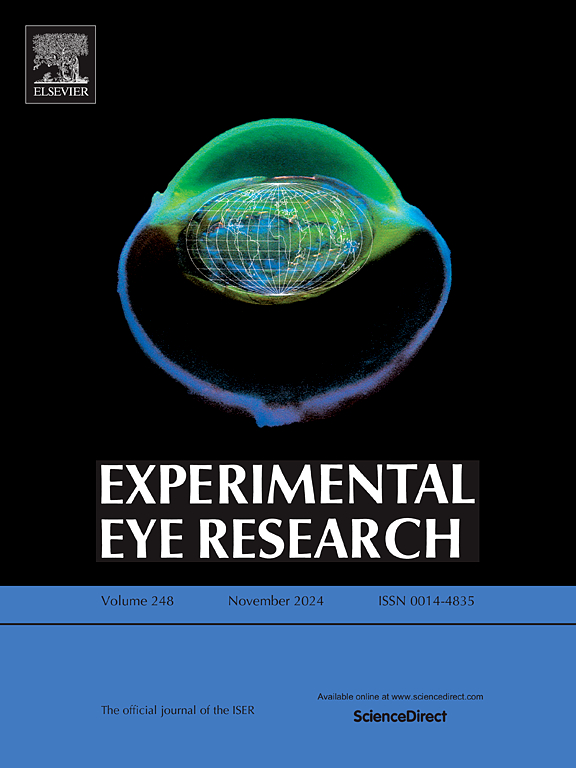视网膜色素上皮细胞氧化应激对 LAMTOR1 的调控:对老年性黄斑变性发病机制的影响
IF 3
2区 医学
Q1 OPHTHALMOLOGY
引用次数: 0
摘要
氧化应激是老年性黄斑变性(AMD)的一个重要致病因素。自噬是一种对抗氧化应激的机制。LAMTOR1 在添加或剥夺氨基酸的情况下,通过在溶酶体上招募或分解 mTORC1 来调节其活性。这种调节抑制或增强了自噬。我们的研究探讨了氧化应激是否会影响 LAMTOR1,从而使其适应氧化条件。我们采用了氧化应激因子--甲萘醌(VK3)和4-羟基壬烯醛(4-HNE),观察到在短期(1小时)和长期(24小时)暴露后,人和小鼠视网膜色素上皮细胞(RPE)中的LAMTOR1均有所减少。Nrf2 的过表达会增加 RPE 中的 lamtor1 mRNA 和 LAMTOR1 蛋白。为了确定 Nrf2 是否调控 lamtor1 的转录,我们将 lamtor1 启动子的缺失突变体克隆到荧光素酶报告基因中。虽然启动子含有抗氧化反应元件,但转录活性取决于Nrf2与含有转录起始位点的构建体之间的相互作用。此外,组蛋白乙酰转移酶抑制剂 p300 能显著降低 Nrf2 驱动的转录。相应地,Nrf2过表达会增加乙酰化组蛋白3和p300的水平。4-HNE 导致的 LAMTOR1 减少被epstatin A 和 NH4Cl 逆转,这两种物质能阻止溶酶体降解。4-HNE 增加了 TFEB 的核转位,而 LAMTOR1 的过表达则逆转了这种转位。在体内,与注射 PBS 的对照组相比,注射 NaIO3 的小鼠光感受器和 RPE 层的 LAMTOR1 水平下降。总之,氧化损伤主要通过溶酶体降解减少了 LAMTOR1,尽管 Nrf2 介导的组蛋白乙酰化增强了 lamtor1 的转录。这项研究揭示了氧化应激对lamtor1的一种先前未被发现的调控机制,提示了LAMTOR1在AMD发病机制中的新作用。本文章由计算机程序翻译,如有差异,请以英文原文为准。

Regulation of LAMTOR1 by oxidative stress in retinal pigment epithelium: Implications for age-related macular degeneration pathogenesis
Oxidative stress is a critical pathogenic factor for age-related macular degeneration (AMD). Autophagy serves as a mechanism to counteract oxidative stress. LAMTOR1 regulates mTORC1 activity by recruiting or disassembling it on the lysosome under the addition or deprivation of amino acids. This regulation inhibits or enhances autophagy. Our study investigates whether oxidative stress impacts LAMTOR1, thereby adapting to oxidative conditions. We employed oxidative stressors, menadione (VK3) and 4-hydroxynonenal (4-HNE), and observed a reduction of LAMTOR1 in both human and mouse retinal pigment epithelium (RPE) following short-term (1h) and prolonged exposures (24h). Nrf2 overexpression increased both lamtor1 mRNA and LAMTOR1 protein in the RPE. To determine if Nrf2 regulates lamtor1 transcription, we cloned the deletion mutants of the lamtor1 promoter into a luciferase reporter. Although the promoter contained antioxidant response elements, transcriptional activity depended on the interaction between Nrf2 and the constructs containing the transcriptional start site. Moreover, Nrf2-driven transcription was significantly reduced by an inhibitor of histone acetyltransferase, p300. Correspondingly, Nrf2 overexpression increased levels of acetylated histone 3 and p300. The reduction in LAMTOR1 by 4-HNE was reversed by pepstatin A and NH4Cl which block lysosomal degradation. 4-HNE increased TFEB nuclear translocation which was reversed by LAMTOR1 overexpression. In vivo, LAMTOR1 levels decreased in the photoreceptor and RPE layers of NaIO3-injected mice, compared to PBS-injected controls. In conclusion, oxidative injury reduces LAMTOR1, predominantly through lysosomal degradation although Nrf2-mediated histone acetylation enhances lamtor1 transcription. This study reveals a previously unrecognized regulatory mechanism of lamtor1 by oxidative stress, suggesting a novel role for LAMTOR1 in the pathogenesis of AMD.
求助全文
通过发布文献求助,成功后即可免费获取论文全文。
去求助
来源期刊

Experimental eye research
医学-眼科学
CiteScore
6.80
自引率
5.90%
发文量
323
审稿时长
66 days
期刊介绍:
The primary goal of Experimental Eye Research is to publish original research papers on all aspects of experimental biology of the eye and ocular tissues that seek to define the mechanisms of normal function and/or disease. Studies of ocular tissues that encompass the disciplines of cell biology, developmental biology, genetics, molecular biology, physiology, biochemistry, biophysics, immunology or microbiology are most welcomed. Manuscripts that are purely clinical or in a surgical area of ophthalmology are not appropriate for submission to Experimental Eye Research and if received will be returned without review.
 求助内容:
求助内容: 应助结果提醒方式:
应助结果提醒方式:


